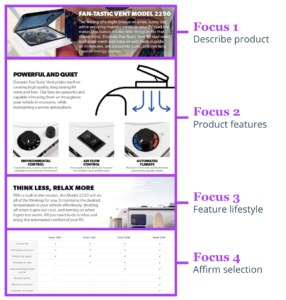We don’t need to lament on the mighty, impenetrable ecommerce force that is Amazon. With 66% of product searches beginning on Amazon and 9 out of 10 customers conducting price checks on Amazon before buying, many retailers and brands are jumping into the Amazon marketplace to reach customers. But, a retailer’s relationship with Amazon and its Amazon customer experience is anything but plug-and-play. In other words, “it’s complicated” and you need to be proactive to increase conversion rates in order to drive sales on the platform.
Take Dometic: the world’s largest manufacturer of mobile living products that sells in over 100 countries. In North America, Dometic maintains 6,000 dealers and distributors, including Amazon, many of whom sell online. Having rogue sellers—essentially anyone with a camera phone—creates a whole new barrel of problems for any retailer, from inventory to branding.
Reclaim Your Brand On Amazon and Increase Conversion Rates
How can you maintain brand and product integrity when multiple sellers are engaging in a “race to the bottom,” dropping prices and pumping out product pages with little to no content? How can a retailer grow, or even maintain, sales and profitability within existing channels while capitalizing on its Amazon opportunity in such a cluttered environment? Not only does the customer experience suffer, the brand also misses countless opportunities to build a lasting customer relationship.
It isn’t hopeless. Total retail partners, like SupplyKick, bring a fully loaded oxygen tank to retailers and brands marooned in the opaque depths of Amazon. From customer service, to logistics and inventory, to launching entire rebrands, SupplyKick helped Dometic get its sea legs across Amazon 1P, Amazon Direct and the Amazon marketplace.
In the session “Harnessing the Power of the Amazon Shopper” at CommerceNext 2019 in NYC, Josh Owens (CEO at SupplyKick) and Derek Laninga (Retail Sales Director at Dometic) talked about how Dometic was able to use Amazon to increase conversion rates, sales and long-term customer acquisition.
Building Amazon Ads and PDPs to Convert
During a time when Dometic hit an internally chaotic peak—undertaking several acquisitions along with a total company rebrand that required launching new and existing products—it also faced the multiple seller “race to the bottom” problem on Amazon. Dometic needed a strategy to create an on-brand customer experience within Amazon to capitalize on their growth potential in that channel.
Using one, simply, “non-sexy” multi-million dollar selling product as an example, the RV Vent Fan, Dometic and SupplyKick proved out the effectiveness of a cohesive Amazon strategy. They upgraded product pages with customer-centric copy, lifestyle photography and A+ content, used ads appropriately to cut into competitor market share and provided invaluable customer service and inventory support to cover all the problem touch-points. Each element plays its part to drastically increase conversion rates.
Photography
According to Owens, 70% of customer decisions on Amazon are made because of photography. With this in mind, Dometic curated its product photos at the top of the PDP to focus on the actual product specifications (adding copy to the photos to point out specific features), along with on-brand lifestyle photography to show the product in high res context. Given most third party sellers don’t have the resources for their own product photo shoots, this is one of the quickest ways a retailer or brand can leverage its current assets to stand out to customers. And it works—Dometic saw a 26% increase in conversion on its vent fan strictly because of its photography changes.
Copy
Also above the fold on an Amazon PDP resides space for summarized product descriptions in bulleted form. Another area where a professionally marketed product can really shine, the contrast between a third party seller or Amazon’s copy and Dometic’s consumer-focused copy is usually stark.

(Pictured above: copy for Dometic’s RV Vent Fan page. Before: third party or Amazon sellers. After: SupplyKick’s features bullet points for Dometic.)
SupplyKick’s revised copy on the vent’s PDP “attacks the long-tail of what customers are looking for.” It addresses customer questions and concerns before they are asked, and breaks down the features into terms any customer with any level of product education could understand. The result: Dometic saw a 30% increase in conversion from the copy alone.
A+ Content
This is the part of the page where a retailer has the opportunity to build enhanced brand content that takes a customer through the entire buying journey, and should ultimately close the deal. When done right, A+ content replicates the same customer journey experienced in-store, mitigating return and customer service issues, and subsequently, narrowing profitability issues.

(Pictured above: A+ section for Dometic’s RV Vent Fan page.)
The formula for A+ is simple:
1. Reintroduce the product and describe what it is.
2. Hit hard on the product features (especially helpful in reducing returns).
3. Put the product into context by showing how other customers use it with lifestyle imagery and descriptors.
4. Provide a comparison chart to help customers find the exact product for their needs.
After employing this formula, Dometic saw a 25% improvement on conversion.
Ads
Taking full advantage of and seeing success with Amazon advertising involves laser focus on the competition. Half the battle for the customer is ensuring the right ad is on the right competitor page; once a customer clicks through your ad on a competitor page, they are likely to convert. Owens recommends placing ads for both lower and higher priced products, along with those that receive better reviews than the competitor’s product. When properly placed, Amazon ads can result in both margin enhancing and margin positive results, along with a higher volume of market share.
Logistics and Customer Service
While virtually any marketing team can execute all the above on Amazon, it takes diligence and commitment to a long term strategy to regain ultimate control of product sales from those rogue Amazon sellers. Once a brand incorporates the necessary photography, copy and A+ components and begins converting more, the brand has to plan accordingly. It needs to ensure the products are in stock, evaluate if they will be Prime eligible, determine what will be manufacturer-fulfilled or seller-fulfilled and oversee all the intricate customer service pieces.
Partners like SupplyKick can handle it all. The average 9-to-5 retail and seller shops don’t have the bandwidth within their customer service departments to handle the 24/7 demand of the Amazon consumer, so a partner picks up the slack. A responsive, comprehensive customer service experience that covers all distribution centers quickly becomes a key component to increasing sales.
Never Become Complacent on Amazon
Once the pieces all come together, that isn’t time to sit back and watch the sales soar. Building a brand story on the Amazon marketplace and bringing customers back to the brand through ads on competitor pages takes time, testing and analysis. Think first about what customers look for and where to find them, then build the pieces sequentially to reflect that strategy. A brand has to tell a strong story throughout the Amazon customer experience—through its A+ pages and even through its ads by ensuring highly reviewed, competitive products are shown on the appropriate competitor pages. It needs to test and retest all PDP content, analyze sales cycles and remember to address seasonality. Not the simplest set of tasks, nor the quickest in results, but the increased conversion rates and sales will be well worth the wait and effort.
Watch the full session on our YouTube channel and apply today to see these types of sessions live at CommerceNext 2020.
Related Posts
-
Are You Prioritizing Affiliate In Your Marketing Strategy? You Should Be.
Despite it being the height of the holiday shopping season,…
-
Forbes + CommerceNext: You Can Win On Amazon With Three Simple Strategies
ARTICLE SUMMARY: Amazon is the largest ecommerce platform in the US.…
-
The Role Of Amazon In A World Of Direct-To-Consumer Brands
How three companies navigate the pros – and cons –…




